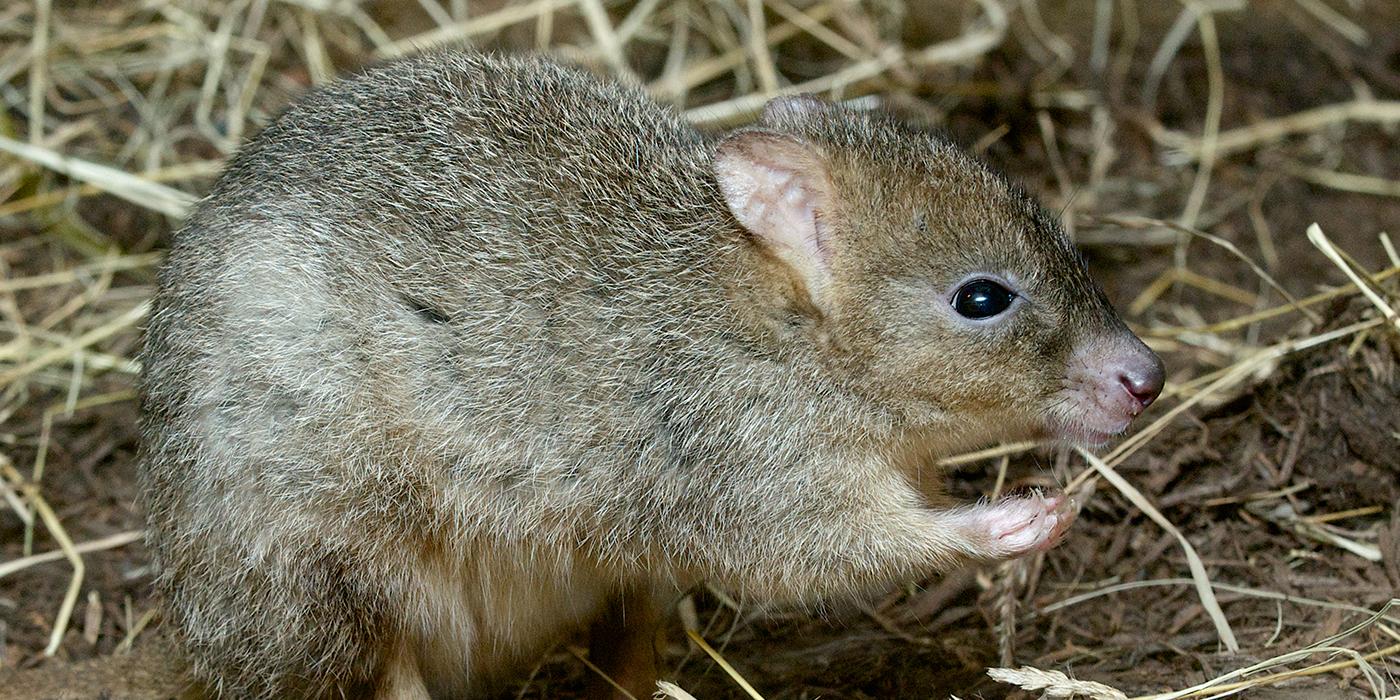Physical Description
Brush-tailed bettongs have relatively large eyes and round ears. Males and females are similar in appearance, though males are typically slightly larger. Their fur is dense and long. They are normally buff gray to grayish brown on their backs and flanks, and paler underneath. One of this species' more noticeable features is a characteristic black crest of fur extending from the tail.
Brush-tailed bettongs are completely bipedal, with hind feet measuring not only longer than front feet, but longer than the head of the animal. They use their front feet for digging.
Size
Brush-tailed bettongs are small, ranging in size from 11 to 18 inches (28 to 45 centimeters) in body length with a 10 to 13 inch (25 to 33 centimeters) long tail.
Native Habitat
Native to Australia, brush-tailed bettongs formerly ranged across much of the Australian mainland south of the tropics, existing in over 60 percent of the country. Today, that distribution has reduced to a handful of nature reserves in the southwest portion of the country. There have also been a handful of translocations attempted throughout South Australia and New South Wales that have been met with mixed success.
Brush-tailed bettongs historically prefer desert grasslands and forests. However, today they live only in forests, woodlands and eucalyptus scrublands.
Lifespan
Average lifespan for brush-tailed bettongs in the wild is 4 to 6 years. In human care, brush-tailed bettongs can live into their teens.
Communication
With keen senses of smell and hearing, bettongs use pheromones in their urine, feces, and scent glands to communicate with others.
Food/Eating Habits
In addition to never drinking water, they also refrain from eating green plant material. The brush-tailed bettong primarily eats fungus, supplementing its diet with bulbs, seeds, insects and resin. They identify and find the fruiting bodies of underground fungi by smell, and dig them up using their front claws. Its stomach has adapted to include increased bacteria, which allow for the breakdown of the fungi and the release of beneficial nutrients.
Brush-tailed bettongs at the Smithsonian's National Zoo consume a diet that can include yams, carrots, seeds, mushrooms, parsnip, squash and dandelion greens.
Sleep Habits
Brush-tailed bettongs are nocturnal animals, spending the daytime resting in well-hidden nests made of grasses and bark. They forage between dusk and dawn.
Social Structure
This species is largely solitary, coming together only for courtship and mating.
Reproduction and Development
Breeding is year-round and continuous; females give birth to a maximum of three young each year, beginning at the age of 170 to 180 days. Although twins have been observed, young are normally born singly after a 21-day gestation period. As is common in marsupials, bettongs are born substantially underdeveloped and will crawl into their mother's pouch where they will remain for 90 to 98 days drinking milk and developing. After emerging from the pouch, the young bettong will accompany its mother, continuing to suckle and sharing the nest until the next infant leaves the pouch and takes over the nest space.
Conservation Efforts
Brush-tailed bettongs are critically endangered. They have experienced a significant amount of localized extinction, greatly reducing their original habitat range.
Historically, fox and cat predation combined with habitat destruction have presented serious threats to brush-tailed bettongs. However, there has been an unexplained dramatic population decline since 2001, wiping out smaller populations and greatly reducing larger ones. This means that reduced genetic diversity is another threat to brush-tailed bettongs. Suspected causes of this recent, rapid decline could include predation, disease and lack of food.
In an attempt to regrow the population of brush-tailed bettongs, two main conservation initiatives have been put into place: careful habitat management and the monitoring and reduction of the local fox population. These actions are being coordinated by the Department of Environment and Conservation in Western Australia. The department is looking into and testing translocation sites for possible introduction/reintroduction of bettongs. Additional study is needed to better understand the role of domestic or feral cats in bettong population declines.
Help this Species
Share the story of this animal with others. Simply raising awareness about this species can contribute to its overall protection.
Smithsonian's National Zoo and Conservation Biology Institute. (n.d.). Brush-tailed bettong. Retrieved October 17, 2025, from https://nationalzoo.si.edu/animals/brush-tailed-bettong
Animal News

7 Spooktacular Animal Facts for Halloween ›

Meet the Orangutans Living at the Smithsonian’s National Zoo ›


